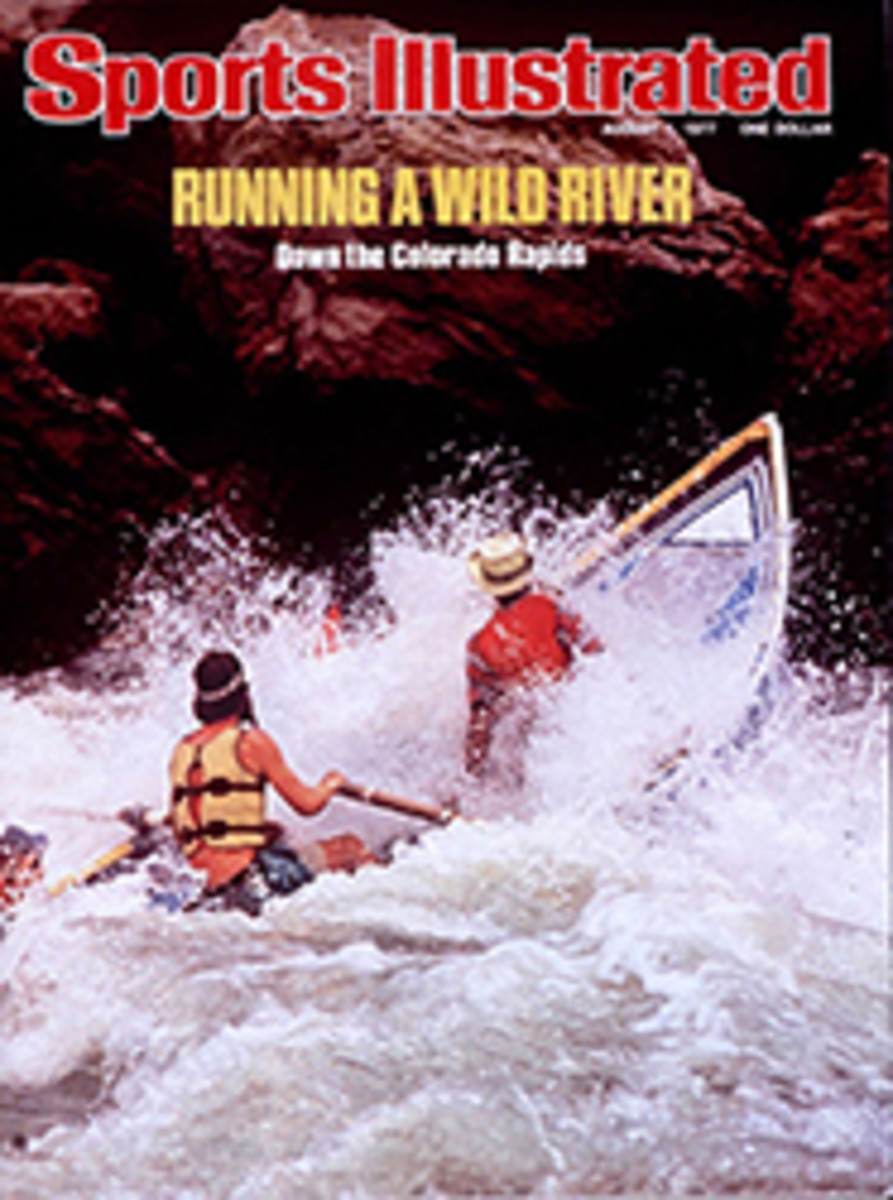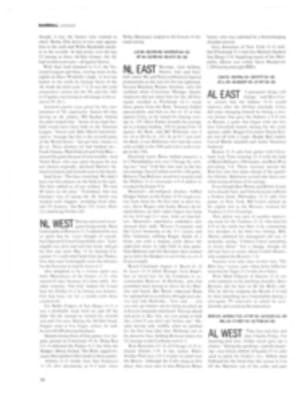
JUST KEEP YOUR HEAD ABOVE WATER
The Colorado River offers stretches of serenity and beauty, of majesty and peace. This isn't one of them. But there is an exhilaration in running the river's rapids in a small wooden boat, rather like what one might enjoy riding a spray-lashed roller coaster. To ride on, turn the pages.
GRANDEUR AND TURMOIL
Wooden dories drift effortlessly down the Colorado River, dwarfed by the soaring granite walls of the Grand Canyon that rise abruptly from the river's edge. The flowing water reflects the bright, striped boats. Only the rhythmic stroke of oars disrupts the eerie quiet, sending circular puddles behind the dories. But soon the rumbling sound of distant water slapping at walls and over rocks intensifies, until a bend in the river reveals to the eye what the ear already knows. The dories are approaching a rapids.
The oarsmen stand, one by one, like soldiers at attention, peering down toward the quickening waters. Their oars are motionless as the boats slip sideways. The passengers remain seated, tugging tight the straps on orange life preservers that had been draped loosely around their shoulders during the quiet miles. Their hands reach for the gunwales, or under seats, or out to each other, clinging to whatever they can grab. Shaping his course, an oarsman sits and pulls hard on the downstream oar, spinning the dory's stern around so that he faces head on into the rapids. Now, tugging furiously with both oars against the river's pull, he aims his boat down a boiling trough and into a wall of water.
Waves crested with white foam thrust the bow up and out of the water like a sailfish dancing at the end of a fisherman's line. For a moment the dory hangs suspended like a punching bag, rocking from side to side as waves sweep underneath, leaving one oar, and then the other, flapping uselessly at air. Before long the passengers are drenched and the dory is partially swamped. Jostled and often shivering in knee-deep, 55° water, the occupants start to bail between the enormous sprays of the river. Each oar bends like a vaulter's pole as the oarsman yanks the dory away from boulders and out of whirlpools, his strength exhausted by the time the rapids subside into a gentle, gurgling, controllable force.
Every summer professional outfitters, licensed by the National Park Service, take 14,000 people on the 277-mile journey from Lee's Ferry, Ariz. to Lake Mead, Nev. Of these, only one, Grand Canyon Dories, runs the river with the kind of dories pictured here, taking a more or less leisurely 14 to 18 days to do it. Other outfitters offer the trip in rubber rafts propelled by motors. Carrying up to 30 passengers apiece, as opposed to five per dory, these make the run in eight to 10 days.
This year trips of both kinds were officially postponed until June because the water level of the Colorado was dangerously low. The Bureau of Reclamation, which regulates the river's level by controlling the Glen Canyon Dam, had simply shut off the flow during April and May to build up a supply that had been severely diminished by the winter drought. Some of the rubber craft did leave as early as April, but the 16-foot wooden boats lay strapped to the double-decker beds of trucks, waiting for the normal summer flow of 16,000 to 18,000 cubic feet per second (cfs).
It came in mid-June. With the Bureau's release of the Glen Canyon supply, the Colorado rose to virtually its usual height and the dories were off, maneuvering through every rapids from tame Badger Creek to the wild, treacherous Lava Falls. Each stretch of rapids is ranked on a scale of one to 10, determined by degree of difficulty at different water levels. Soap Creek Rapid, for example, the first real challenge for the river runner, is rated five for 6,000 to 8,000 cfs, but jumps to seven at 20,000 cfs. It was here, in 1889, that five cedar boats capsized, spilling the occupants, who had come to survey the canyon for a railroad route, into the river. What remains of that trip is an inscription to the railroad company president, Mr. Frank M. Brown, carved into the rock. Brown had vetoed life jackets as "unnecessary," and he perished in Soap Creek.
Nowadays such foolhardiness is not permitted. Crew and passengers on dory trips spend some long hours staring at the rougher rapids from the shore. After a while one of the dories, minus paying customers, tests the rapids, steering the course that from shore appears to be the safest. The other oarsmen then guide their boats past an audience divided into those relieved to be sitting this one out and those who long to risk the plunge into frigid water for the thrill of riding the big one. The choice is not theirs to make. The dories will come ashore downstream, passengers and crew will be reunited and the procession will begin anew.
The boat Tapestry Wall leads a pack of six into stiller waters. Across each dory's bow a name is painted in large block letters, a remembrance of some natural wonder destroyed by man's technology. When the Glen Canyon Dam was completed in 1963, two of the Grand Canyon's treasures were submerged forever. Tapestry Wall, once a pink sandstone cliff in Glen Canyon, is gone, and Music Temple, so named by an early explorer, ironically lies hidden beneath the lake that bears its admirer's name—Lake Powell.
Major John Wesley Powell kept a diary in which he wrote of Music Temple: "When 'Old Shady' sings us a song at night, we are pleased to find that this hollow in the rock is filled with sweet sounds. It was doubtless made for an academy of music by its storm-born architect; so we name it Music Temple."
Now at night travelers lie on the beach in sleeping bags, and the Colorado's restful murmur lulls them into sleep. As one wrote a few years ago, "The moon developed a very pleasant habit of hanging just between two canyon peaks, and would gleam down from on high, making us feel very privileged indeed." Eight hours of darkness pass, and at morning light the dories set out again, at the river's own pace.
FIVE PHOTOS
JOHN BLAUSTEIN

